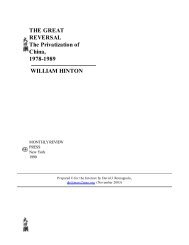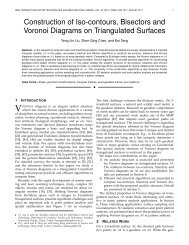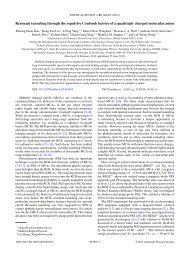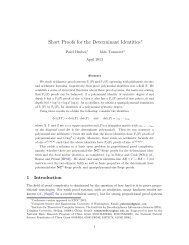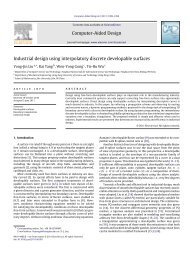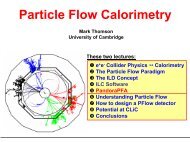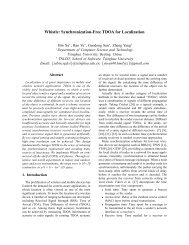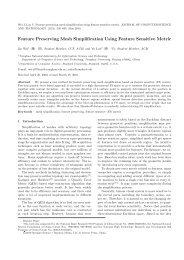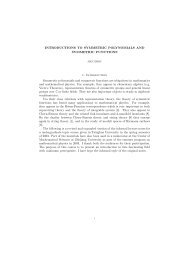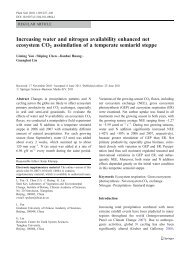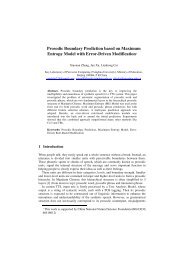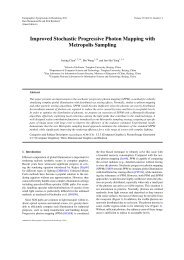Some variational problems in conformal geometry
Some variational problems in conformal geometry
Some variational problems in conformal geometry
Create successful ePaper yourself
Turn your PDF publications into a flip-book with our unique Google optimized e-Paper software.
SOME VARIATIONAL PROBLEMS IN CONFORMAL GEOMETRY 225<br />
If A g is semi-positive def<strong>in</strong>ite, then (M n ,g) has nonnegative scalar curvature<br />
and nonnegative Ricci curvature. For the case k =2,Z.Hu,H.LiandU.Simon<br />
([HLS]) showed that<br />
Theorem 3.5 ([HLS]). Let (M n ,g) be a compact locally <strong>conformal</strong>ly flat<br />
manifold with σ 2 (g) a non-negative constant. If the Ricci tensor is semi-positive<br />
def<strong>in</strong>ite, then (M n ,g) is a space form for n =3and is either a space form or a<br />
space S 1 × N n−1 with N n−1 a space form for n ≥ 4.<br />
For the complete case, similar results are rare. Z. Hu, H. Li and U. Simon<br />
proved <strong>in</strong> [HLS]:<br />
Theorem 3.6 ([HLS]). Let (M n ,g) be a complete locally <strong>conformal</strong>ly flat<br />
manifold with constant scalar curvature. If the Ricci tensor is semi-positive def<strong>in</strong>ite,<br />
then the universal cover ˜M of M n with pull-back metric is isometric to S n (c), R n<br />
or R × S n−1 (c).<br />
4. Renormalized volume coefficients v (2k) (g)<br />
Renormalized volume coefficients, v (2k) (g), of a Riemannian metric g, were<br />
<strong>in</strong>troduced <strong>in</strong> the physics literature <strong>in</strong> the late 1990’s <strong>in</strong> the context of AdS/CFT<br />
correspondence. Given a manifold (X n+1 ,M n ,g + ) with boundary ∂X = M. Letr<br />
be a def<strong>in</strong><strong>in</strong>g function for M n <strong>in</strong> X n+1 such that r>0<strong>in</strong>X and r =0onM, while<br />
dr| M ≠0.<br />
For any given Riemannian manifold (M n ,h 0 ), Fefferman-Graham ([FG])<br />
proved that there is an extension g + of h 0 , which is “asymptotically Po<strong>in</strong>care<br />
E<strong>in</strong>ste<strong>in</strong>” <strong>in</strong> a neighborhood of M n , i.e., <strong>in</strong> [0,ɛ) × M n for some ɛ>0,<br />
(4.1) Ric(g + )=−ng +<br />
as r → 0. Locally we can write<br />
(4.2) g + = 1 r 2 (dr2 + h ij (r, x)dx i dx j ),<br />
where h(0, ·) =h 0 (·) andh(r, ·) is a metric def<strong>in</strong>ed on M c := {r = c} ⊂X when c<br />
is sufficiently small, {x i } are local<br />
√<br />
coord<strong>in</strong>ates of M n .<br />
det hij (r,x)<br />
Suppose the expression of √ near r = 0 is given by<br />
det hij (0,x)<br />
√<br />
det hij (r, x)<br />
∞<br />
(4.3)<br />
√<br />
det hij (0,x) = ∑<br />
v (k) (x, h 0 )r k ,<br />
where v (k) (x, h 0 ) is a curvature <strong>in</strong>variant of the metric h 0 for 2k ≤ n. The follow<strong>in</strong>gs<br />
are some important properties of v (k) (g):<br />
• Graham ([G0]): v (k) vanishes for k odd.<br />
• Graham ([GJ]): when (M,g) is locally <strong>conformal</strong>ly flat, v (2k) (g) isequal<br />
to σ k (g) up to a scal<strong>in</strong>g constant.<br />
Here are some expressions of v (k) (g) for lower k’s.<br />
k=0<br />
(4.4) v (2) (g) =− 1 2 σ 1(g), v (4) (g) = 1 4 σ 2(g).<br />
For k = 3, Graham and Juhl ([GJ]) listed the follow<strong>in</strong>g formula for v (6) (g):<br />
(4.5) v (6) (g) =− 1 8 [σ 1<br />
3(g)+<br />
3(n − 4) (A g) ij (B g ) ij ],<br />
This is a free offpr<strong>in</strong>t provided to the author by the publisher. Copyright restrictions may apply.



